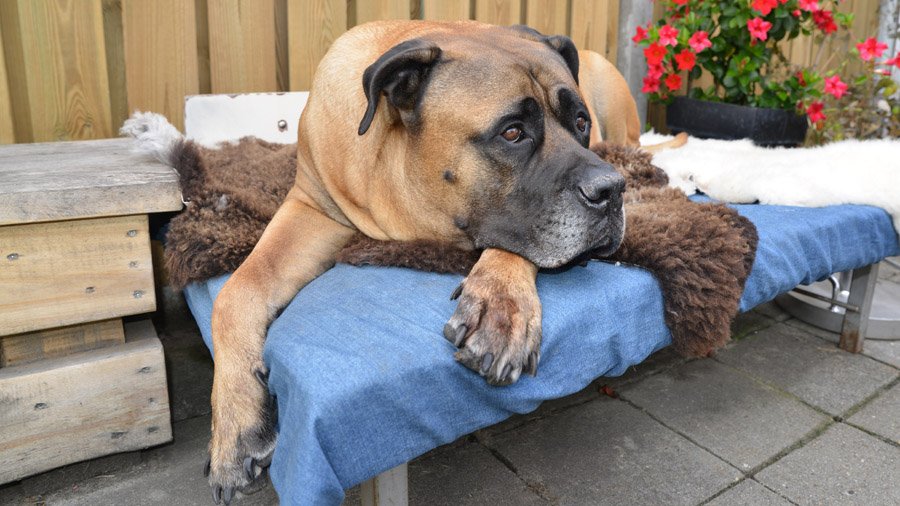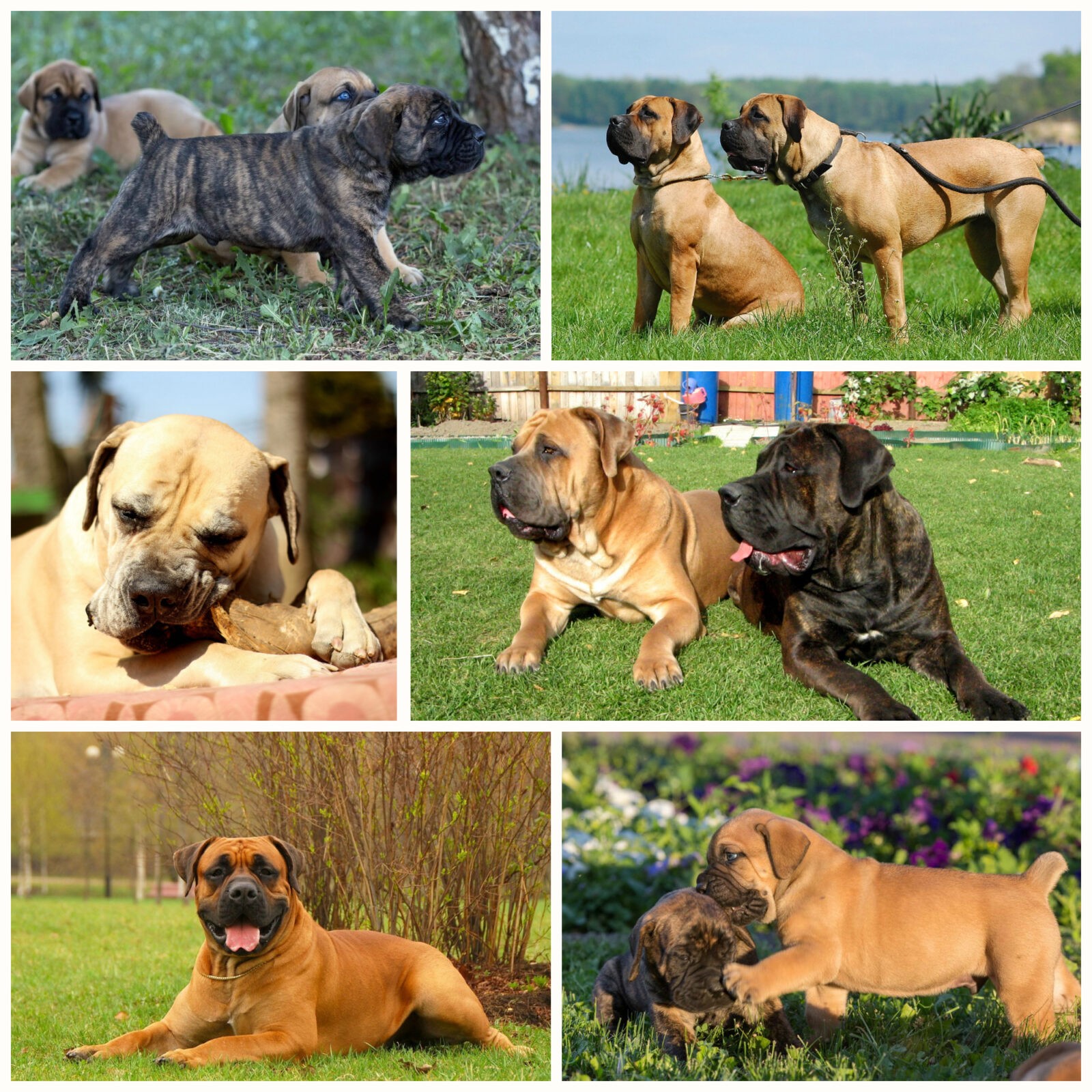The South African Boerboel breed is a molossoid dog whose main purpose today is to protect the life and possessions of its owner. South Africa is considered to be the birthplace of these powerful, strong in health, extremely hardy creatures, but, according to scientists, their ancestors were in other parts of Africa, as well as on the territories of other continents.

Brief description of the South African Boerboel breed
The main task of Boerboels in the past was to protect livestock from a wild beast, and in ancient times these dogs also protected the lives of people whose occupation was farming. History knows about the participation of such dogs in combat.
South African Boerboels are also called South African Mastiffs, Boer Mastiffs, or simply Boer dogs (Boers - white-skinned peasant colonists of European origin who inhabited the territories of South Africa).
Today, there are nurseries of South African Boerboels in almost all countries, and the breed has many fans. In fairness, there are also opponents, since there is some statistics according to which Boerboels, whose owners did not consider it their duty to properly raise a dog, attacked people, which led to dire consequences and even deaths. Therefore, disputes around the breed are quite relevant in our time, and who is to blame - a strong dog or its weak-willed owner, nonchalantly allowing the animal to shape its own behavior - unknown.
basic information
| Breed name: | South African Boerboel |
| Country of origin: | Africa |
| The time of the birth of the breed: | 17th century |
| Type of: | working dogs |
| The weight: | 60 – 90 kg |
| Height (height at the withers): | 55 - 60 cm |
| Life Expectancy: | 10 - 15 years old |
|
ICF classification:
|
not recognized |
| Puppies price: | 200 – 1000 $ |
| Most popular nicknames: | list of nicknames for boerboel |
Evaluation of the characteristics of the South African Boerboel breed
| Adaptability
(a definition meaning how easily a dog can adapt to changes in life) |
🐶🐶🐶 |
| Shedding level
(Level and frequency of hair loss in the animal) |
🐶🐶🐶 |
| Tenderness level
(The level and amount of tenderness and affection that the dog gives in return for attention to itself) |
🐶🐶🐶 |
| Exercise needs
(Dog's daytime activity level) |
🐶🐶🐶🐶 |
| Social need
(The required number of contacts of the dog with other animals, as well as people) |
🐶🐶🐶 |
| Apartment content
(A factor that determines the level of noise and other inconveniences that a dog can deliver to owners in relation to the size of the apartment to the size of the dog) |
🐶🐶 |
| Grooming
(The number of bathing, brushing, and the number of professional grooming sessions required for the dog) |
🐶 |
| Friendliness in an unfamiliar environment
(Features of the behavior of a dog in a society with strangers or in an unfamiliar environment) |
🐶🐶 |
| Tendency to bark
(Tendency to bark and its frequency and volume) |
🐶🐶 |
| Health issues
(Potential health status of the dog) |
🐶🐶🐶 |
| Territoriality
(The dog's tendency to protect his home, yard, or even his owner's car) |
🐶🐶🐶🐶🐶 |
| Friendliness to cats
(The tendency towards tolerance for cats and decreased manifestation of hunting instincts) |
🐶🐶 |
| Intelligence
(The ability of the dog to think and solve emerging difficulties (not to be confused with learning!) |
🐶🐶🐶🐶 |
| Education and training
(The level of difficulty in training the dog to perform certain actions) |
🐶🐶🐶🐶 |
| Friendliness to children
(A factor that determines how friendly a dog is to children, whether he likes to play with them and tolerate some childish pranks) |
🐶🐶🐶🐶 |
| Game activity
(The concept is determined by its very name, and, as a rule, is found in almost all dogs) |
🐶🐶🐶 |
| Observation
(The ability of a dog to detect the presence of a stranger on its territory) |
🐶🐶🐶🐶🐶 |
| Friendliness to other dogs
(The tendency of the dog to find common language with his other relatives) |
🐶🐶 |
Appearance
South African Boerboels - these are strong, tall dogs (their height at the withers is at least 60 cm for males and at least 55 for females), weight is in the range of 60-90 kg. Heavy dogs of this breed are very maneuverable and fast. Head Boerboels are proportional to the whole body, wide, rectangular in shape. The chewing muscles are well developed, the cheekbones are also muscular. Muzzle deep and broad, with folds of skin on the forehead when the dog is alert or interested. The muzzle of the Boerboel gradually tapers to the nose, whose nostrils are pronounced. Jaws powerful, wide, teeth have a scissor bite. Eyes widely spaced, oval. Ears set high, broad at the base and narrower towards the rounded tips. Neck very broad, of medium length, muscular, smoothly fitting the area of the dog's head with its body, a slight dewlap is acceptable on the neck. Frame elongated, rectangular in shape, muscular and convex in the back and croup. Tail wide in diameter, set high (may be docked). limbs with strong bones, muscular, with strong shoulder blades, thighs and shins. Paws wide, rounded, directed forward, the hind legs are somewhat smaller than the front. Wool Boerboels are short, very dense, smooth. Boerboel coat color may be fawn, red or brindle. There may be white markings on the chest and legs. Most often, on the muzzle of a dog, the hair is painted black - the so-called mask. In addition, the palate, eyelids, nose, lips, pads of fingers, claws, as well as the genital area of the dog have black pigmentation.
South African Boerboel photo:

The history of the origin of the South African Boerboel breed
The nature of dogs of the South African Boerboel breed
Experienced owners, breeders and cynologists note the balanced nature of Boerboels, a loyal attitude towards pets (such a tolerant attitude should be instilled from an early age, since a grown dog will chase other pets of the owner, especially dogs), love for the owner and members of his family. They note the excellent attitude of Boerboels towards children. Often these huge dogs (whose weight is a little short of a hundredweight) play with children and allow those pranks on themselves. Boerboels are excellent guards and watchmen, they can be safely entrusted with both life and property. They are wary of strangers, until they understand who is in front of them - a friend (or guest) of the owner or an enemy who has encroached on someone else's property. The South African Boerboel can spend a matter of seconds solving a problem, independently determining what to do in a situation.
South African Boerboels have a rather strong character, they like to dominate, proving their case. That is why the owner of such a dog should not be soft, a person who will not be able to show rigidity in some cases. The owner of such a "serious" dog should always be aware that from the very appearance of the puppy in the house, it will be necessary to show character, teaching the animal the rules of behavior in the family and outside it. In other words, burbuli - dogs with a stable psyche, smart, friendly, loyal and courageous. But only in cases where we are talking about trained, properly trained dogs, obeying the will and commands of the owner, and not their own instincts.
Maintenance and care
South African Boerboels - those dogs that were recreated for the service of man, and not for admiration and delight. That is why there are no special difficulties with caring for a Boerboel. - this is an unpretentious breed, characterized by good health, in need of minimal comfortable conditions. They can live in an apartment, and on the site of a country or private house. It is important that the dog has the opportunity to bypass the territory and move freely, do not keep the Boerboel on a chain. In the case of a dog living in the fresh air, you should think about building a spacious aviary and an insulated kennel, where there will be no place for a draft. These dogs tolerate heat and cold well, but in too severe frosts, you can think about insulating the dog's kennel more or moving its bed into the house.
Combing several times a week to remove dead skin particles and hairs, as well as to improve the dog's blood circulation, cutting nails, brushing teeth and ears, monitoring the health of the animal - that's all the care of the Boerboel. Bathing of these dogs is carried out rarely, as it gets dirty, 2 or 3 times a year.
The only special condition is keeping the South African Mastiff - long and active walks at least 2 times a day for an hour (or more). Moreover, Boerboels need not just calm walking, they need jogging, playing outdoors, following the owner’s commands, and outings with a dog out of town are desirable. A dog limited to boring walks around the household plot, and even more so, if too little attention is paid to it, can become aggressive, bark or howl for no reason, suffer morally, and damage the owner's property.
Training and education
Very large dogs, such as the South African Boerboels, by the age of six months become quite strong and heavy, which becomes difficult to keep on a leash. In addition, those puppies that have not been instilled with the right attitude towards other dogs (and other animals), as well as people, will even not quite consciously cause harm due to their power. Before acquiring such an animal, the potential owner must be fully aware that he will be able to properly build relationships with the dog (where the leader - always human, never - dog), and also with all responsibility will approach the issue of training.
An uncontrolled South African Boerboel in the inexperienced hands of a careless owner is a real terrible weapon, while a dog trained by a competent trainer or its consistent owner will be an excellent watchman and friend of the family, without harming either people or animals. But training a dog by the owner is possible only if the animal respects the owner, realizing that the last word always remains with the person. Boerboels are well trained, although they are somewhat slow in carrying out the owner's commands. They seem to think about what they are trying to teach, and only then do what was shown. While learning commands for Boerboels, the method of encouragement with the help of words of praise and treats is well suited. But you should not use brute physical force, yelling at the dog - this will bring all the efforts in training to zero, and the dog will remember and will not forgive the evil in relation to it.
As a preparation, Boerboels are recommended to master the general and protective training courses. Often, training is entrusted to professionals who know the subtleties of the dog's character and methods of influence to learn commands and skills. Under no circumstances should you buy a Boerboel if the owner does not want to teach the dog not only simple commands, but also proper contact with animals, loved ones and complete strangers. South African Mastiff, aka Boerboel - an animal that must always be subordinate to the owner, otherwise trouble cannot be avoided. And it's not the dog's fault.
Health and disease
Some interesting facts
- Surprisingly, of all representatives of the Molossians, it was Boerboels who earned the fame of extremely dangerous dogs, as evidenced by the numerous attacks of animals on children and adults. How does it happen that rather balanced and self-confident dogs suddenly get terrible nicknames (cannibals, murderers, etc.)? And why do burboels cause such a resonance in society? Everything happens because of the irresponsibility of owners who want to have a prestigious, rare dog, but do not bother to pay attention to training, moreover, such dogs are often set on people and animals for fun. Terrible news reports that tell of Boerboels who have scalped a person or tore a child to pieces are terrifying. Of course, such a dog is likely to be euthanized, and the hype will subside. But the owner will foam at the mouth to prove that the man himself, on whom the dog attacked, is to blame. He will prove, without even realizing, that a South African Boerboel weighing under 90 kg, who went for a walk not only without a muzzle, but even without a leash, is absolutely not trained - this is a potential killer through the fault of the owner himself. In any literature devoted to this breed, the same commandment is always clearly spelled out. - the owner, who has taken such a dog for himself, must be fully aware of all the responsibility to his family and society, only a boerboel brought up from the first months of life will become a real guard and companion, and not a monster rushing at those around him due to the stupidity of his unlucky owner. These dogs - loyal and kind friends of reasonable owners, just requiring a little more attention in the field of adaptation in society and the process of passing training courses in training.
Nurseries and breeders
We borrowed material from the wonderful site of our partners DOGCATFAN.COM about cats and dogs, the author dogcatfan
